Feature Interview with Ron Forse
November, 2020
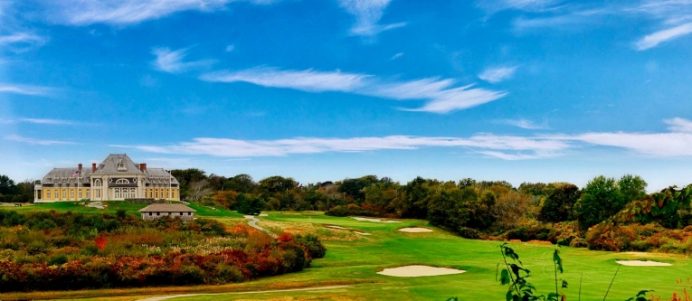
Forse Design has helped restore and preserve America’s design legacy for over three decades. Photo courtesy of Jon Cavalier.
1. When and how did you get into golf course architecture?
Growing up in New Jersey, I had an uncle who designed boats. Like most kids, I looked up to my uncle and wanted to be like him. I wanted to design boats then cars then houses and then at age 13 something about golf just grabbed me. From then on, my goal was to be a golf architect. It even says it underneath my high school year book photo.
Providentially, I was born in West Caldwell in the northern part of the state, which is where Mountain Ridge Country Club was built by Donald Ross. That course, especially its putting greens, informed my eye and spoiled me completely. It set the bar extremely high in my mind for good golf architecture. During my teen years I caddied, did maintenance and played high school golf there – it was our home course (after Ron Pritchard’s restoration, it’s finally getting its just due). Having this course as an influence from the start was a big advantage.
I attended West Virginia University for landscape architecture. Then I moved just north to Uniontown, Pennsylvania and worked for a civil and mining engineering company doing all sorts of work – a great start. In 1987 the Nemacolin Woodlands Resort was bought by Joe Hardy, owner of 84 Lumber Company. Joe likes to throw people out of the boat and let them swim so he was willing to give us a chance to remodel the golf course that the Rockwell family had designed when they owned the resort. From there we got to know the Pittsburgh superintendents and the various dead architect societies. The work grew from there. Since 1998, Jim Nagle, also a lead architect here, has been my team mate.
The 1971 US Open at Merion inspired me to grow the grass tall in our long backyard. I was out there with my wedge constantly.
We use to go to the Jersey Shore and I would study the footprints and undulations of the beach sand, imagining and building miniature golf holes. I think from an early age the randomness of natural landforms captured me. Also, my friends and I would play army in an area near our home that was excavated for construction sand. It left interesting landforms that are not unlike golf features (there are strong parallels between golf and military fields. But that is another topic.)
2. What has changed the most in your profession over the ensuing ~ four decades?
What I see as the biggest change is the golfing public’s appreciation of classic golf architecture, which was incubated by the golf magazines years ago and has gained a lot of moment since. Good architecture is now seen and appreciated as a value add. And golf architects, old and new, are now brands. Geeks will travel long distances to experience fine, land-based golf courses. People are also seeing the value of vistas across golf properties more and more. Views of golf holes are not only to be experienced down the fairway.
3. When you started out, did you have any sense that you would predominantly become a restoration expert?
No. I had no idea. But apparently, we were set up as such by our experience and influences. We did new courses in the 90s but that market was not presented to us as much as restoration. The restorations found us.
4. What three big events most shaped your career?
Aside from being born and raised near Mountain Ridge, I have to say meeting Dr. Michael Hurdzan and conferring with him on a project in West Virginia was invaluable. I never worked for another golf architect, but without Mike’s graciousness and advice I don’t know how far I would have gone. There is no way I could ever repay him.
Secondly, Nemacolin Woodlands in Pennsylvania and Hyannisport Club on Cape Cod were pivotal. Nemacolin was the big start but Hyannisport was our first New England project. Our relationship with Hyport is unbroken for 31 years now. This was the start of us working in our favorite part of the country.
Thirdly, we were offered the opportunity to teach two seminar classes for the Golf Course Superintendents Association of America. This opened the door to working with Riviera in Los Angeles, Wisconsin, and also helped in regard to Florida. There are other big events but these are probably the most pivotal.
5. What components must be present for a restoration project to go well? Similarly, what can a club do to ‘set the table’ for your success?
For a restoration project to go well, you need good resources. Right up front you need a leader at the course who “gets it,” someone who understands what the course should be and the fact that it is not there yet. This may be a committee chairman or a superintendent. A good restoration must also have information resources. We put first priority on old aerial and eye-level photographs. We also want to have the architectural drawings. Some architects like Ross had fairly detailed plans. Others like perhaps Tillinghast, not so much. Of utmost importance is communication. From the architect to the committee and then on to the membership at large. There must be consensus building through the planning and design process or it probably will fail (unless there is benevolent dictatorship.) A plan or improvement program must be effectually sold before it is presented to the members. Education is a big part of the communication. We recommend posting old drawings and photographs around the clubhouse, especially over the men’s urinals, to inform people’s understanding of what the course is supposed to be. Its very helpful to base restoration on practical matters, presenting the functional and playability advantages of the improvements before architectural purity. Also, a successful project depends on staging the work in bites that the membership will accept. Some will want the whole course done at once, most do it in parts.
6. When I was updating the Wannamoisset profile years ago, you told me that Donald Ross had three distinct periods to his career. What were they?
Fairly early on it became apparent that Donald Ross didn’t do the same architecture his whole career (people make a fatal error of logic by thinking an architect’s career was monolithic and did not evolve). Just look at the difference of Tillinghast’s work at Somerset Hills and San Francisco Golf Club – vastly different but both constructed in the same year, 1915.
Back to Ross. His first era we call primitive, which was marked by arbitrary features and sometimes a slightly clumsy but fascinatingly quirky design. This period is from the early 1900s to 1919. His second era was from 1920 to WW II. We call this his mature work. It is now very strategic in nature. This period is also more beautiful in that the features blend better with nature. Ross has evolved beyond the primitive. His third stage of work was his Post War Era, which was very short – 1945 until his death in 1948. At this time his associate J. B. McGovern did most of the work. Essentially, this era is marked by what looks like a blending of 1920s Ross with the architecture of William Flynn. The bulldozer was being used and bunker design had sand flashed in many cases all the way to the top of the feature (McGovern built courses for Flynn at times as well as working for Ross.)
7. Do you have a hidden gem favorite from each of those periods?
Primitive: Rolling Rock in Pennsylvania and Brae Burn near Boston.
The Mature Era: Not one single course can be named but in Rhode Island Misquamicut and Pt. Judith. A great one in Massachusetts relatively unknown is Winchester. Lake Sunapee, Manchester, and Bald Peak are all really fine classics in New Hampshire. Athens CC in Georgia and another.
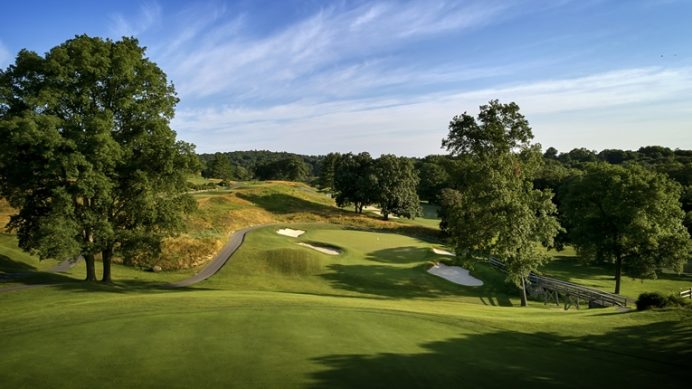
Only in the golf rich northeast could a course of Winchester’s character still fly under the radar. Photo courtesy of Gary Kellner.
Post War Era: Silver Creek near Bethlehem, PA, originally Bethlehem Steel Club.
8. Do you prefer any Ross design era to another?
Yes, the Mature Era. Green complexes like Salem are nothing less than works of art. Interestingly both Primitive and Mature Eras of Ross can be seen at Oakley outside Boston where Ross first worked when he got off the boat.
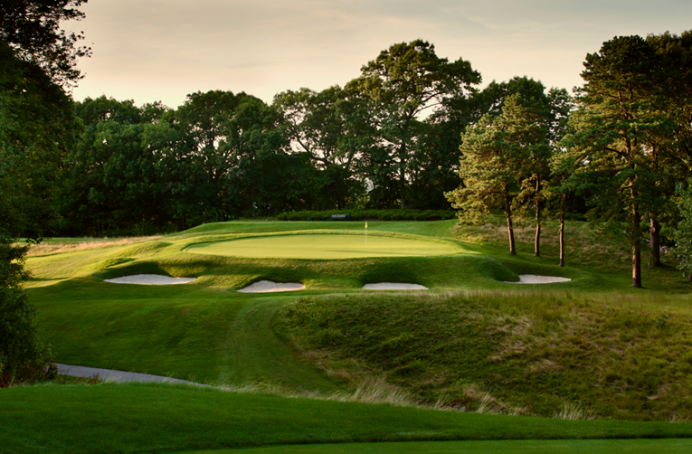
Salem Country Club in the northern suburbs of Boston possesses an outstanding set of greens. Photo courtesy of Paul Dube.
9. Not many people have had the pleasure to tour Bald Peak Colony. How did Ross pack so much golf into its 6,300 yards?
The short answer is because he is Donald Ross. He did the same thing at Oakley. Oakley packs a lot in on its scant 88 acres. Ross’s ability to design for great variety and his expertise in routing make Bald Peak Colony Club what it is, capitalizing on the rising and falling of the land. Also, he used stone walls, which he covered and grassed over.
10. Tell us about the Old Course at Omni Bedford Springs – that was a bold, all-encompassing undertaking, was it not?
It really was a bold and comprehensive project! Everything was reconsidered and rebuilt with a foothold in the history of the three golf architects that had worked there. 1895 Spencer Oldham from Baltimore. He designed one of the first 6,000-yard courses in the U.S. Tillinghast came in 1912 very early in his career and turned it into 9 holes. D. J. Ross, using existing holes in many cases, built a complete 18-hole layout which opened in May 1923. Prone to severe flooding the low portions of the course had to be raised simply to avoid play and revenue shutdown. In fact, the entire resort was shut and had to be restored. The historic hotel as well as the course had to be rebuilt/restored to the tune of approximately $120,000,000. The developer said working on the golf course was simple compared to everything else for him.
~70,000 cubic yards of topsoil were gathered by the lowering and restoring the stream and adjacent wetlands back to pre-colonial elevations. This enabled us to raise grades as needed in the valley for positive drainage and playability. A great example how function and architectural integrity work together. Features from the original 1895 course were retained, even the grass on them. The entire course was restored according to the architecture of each designer yet we incorporated other improvements beyond the restoration. New bunkers and mounds were used to build on the strategy and variety of the course, hole-by-hole, in the way appropriate to the individual architect and the entire 18-hole composition.

Bedford Springs is a museum of the first 30 years of American golf architecture.
11. A 6,500 Ross course in the 1920s with hickories was quite challenging. Today, a 6,500-yard Ross course might be first described as ‘charming.’ What would Ross would make of that? Would he be pleased?
That depends on what “charming” means. One legendary golfer said of Salem, “Nice little course.” In this case “charming” sounds like a pejorative. As far as I’m concerned, I’ll take all the charm you can give me. But it is true we also must restore design intent. I think Ross might not have liked that label. And it is true that he, like other classic architects, would come back later to his own designs and update them. A prime example is the Kahkwa Club near Erie, PA, where a decade after original construction in 1916 Ross recommended a new fairway bunker 40 yards further down the fairway. So, Ross might get a little ticked and make some changes.
12. You’ve spent a lot of time on his courses and acquired much knowledge about Ross. What are your thoughts about Ross the man?
As a designer I think he was a very quick study, an instinctive architect. Ross could be a very good artist as well. His mounding features and green complexes were simply beautiful. And his bunkering artistry is on display in old photos of Seminole in Florida, where he had plenty of time to work his craft due to the onslaught of the Depression. His field notes for changing Wannamoisset were done in one day in June of 1927. He said this was his best course and was yet still making improvements. This is instructive about the man. He was also flexible. At the Sagamore in upstate New York, he allowed himself to route the first hole into the morning sun because its layout was so spectacular.
James Harrison of Pittsburgh who worked for Ross as a young man at Edgewood Country Club remembered Ross as being somewhat quirky in that he liked to go to the 5 and 10 store and look at the little trinkets (I don’t know how identifying this would be of his actual character). Ross’s humility was shown in his acceptance of Jim Harrison’s criticism of his routing at Edgewood. Holes 13 through 18 all have out-of-bounds on their right side. Harrison thought he should have routed them in the opposite direction and told him so years later. According to Jim, Ross replied, “Well maybe you are right.”
As seen in Brad Klein’s book, Discovering Donald Ross, Ross was ready to quit being GM of the Pinehurst Resort when the owner Mr. Tufts wanted to fire one of his fellow Scots due to his lack of enthusiasm toward the guests. Apparently, he was loyal. DJR didn’t only care about golf , he helped establish the Chapel in Pinehurst.
13. What do you think about Ross designs of courses that he supposedly didn’t see? Can you discern differences when he was and wasn’t present?
There is definitely a difference between Ross on site and otherwise. I’ve done the counting and he was on site for about 48% of what’s credited to him during construction. Except for the time in the early 1920s when his wife died, I believe he was on site to do the routing for the majority of his namesakes. That’s my sense. When he was there for construction his influence is readily seen in the sophistication of the undulations of the putting surfaces, the strategic demands are built in. He also infused greater detail into the mounds and bunkers. Admittingly a lot had to do with the construction foreman who was on site every day. Ross was not on any golf course for extremely long periods of time at once.
14. Let’s talk about some of the other architects that you restored, starting with Langford & Moreau at Lawsonia Links. You have been there for over 20 years and the course is approaching perfection. Was your approach different there (a resort course with a green fee under $100) than it would have been if it was a private club?
There was no difference to our approach regardless of the owner or clientele at Lawsonia Links. It was funny how when we started with them, they were charging $5.00 less at the Links course then at their other 18. That kept traffic down on the better course. We wanted to do the best for that course from the start. It was subject to benign neglect, which was actually a very positive thing. The owners had never had a lot of money for the course, but we would still like to see more of the dramatic bunker features have sand placed in them.
It is interesting, like Bedford Springs Resort, how a public access course can have strong hazards and scoring difficulty built in yet be very attractive in the market. People love a challenge and great design.
15. I really agree with that – most golfers hate to be pandered to or to play dumbed down designs! Who is the least appreciated architect of the golden era?
Hands down it is William Langford. But he is starting to get a lot of notice. Hardly anyone knew about him, though we featured his work in a seminar I used to teach on golf course architecture history. When slides of Lawsonia went up on the screen the room fell silent according to Brad Klein who was there. The course is so dramatic and bold I think people almost couldn’t believe that it was that old. Brad started talking about Lawsonia Links and William Langford at that point. Current awareness of Langford and Lawsonia illustrates how far the public’s architectural savvy has come. Lawsonia Links is now ranked #87 in the United States by GOLF Magazine.
I also think Willie Park Jr. is really underrated. His work with putting green contours was among the best. Walter Travis and Devereaux Emmitt deserve more noise, too.
16. Tell us about your work at Davenport Country Club in Iowa. That’s not a pure restoration.
From the moment we saw these stick and circle routing on the topographic map we thought that there was something special there, even before our visit. The routing is definitely the course’s strong foundation. We had no early aerial photos so we had to also rely on our own instincts. So no, it’s not a pure restoration. A big tool in our arsenal was photos of Hirono, Japan designed by Charles Alison who designed Davenport in 1923. Jim Nagle found the photos and had the excellent idea to use them. This made a huge difference in the features. We have often relied on other golf courses by the same architect to enhance the character of a course. DCC is somewhat spartan on a number of bunkers. We added a few more then the original design sometimes for practical purposes such as ball containment on a very hilly site. We also rebuilt 6 of the 18 greens modifying some. One of Alison’s greens was so flat we decided it didn’t fit in with the rest and added more subtle undulation to it. Three of the greens are not in their original location either. So, while it is not a pure restoration the finished course is very true.
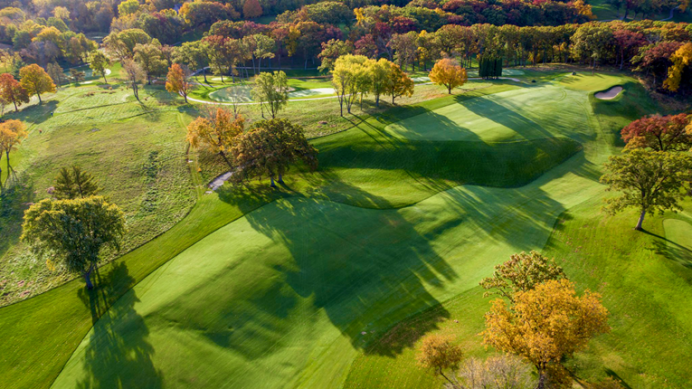
The all-world 7th hole at Davenport CC, as captured by Andy Johnson and his drone.
17. Tell us about the history of its 18th hole. Who deserves credit for its present/amazing configuration?
Alison’s routing had #18 playing as a 90 degree right turn up the hill. This old green is now the practice putting green. Midwest architect Bob Lohman deserves a lot of credit for the current routing. He placed the green across the creek keeping the hole in the valley. Not only is it a much better green location, but the player encounters Cardiac Hill only after he is done with his round. Poor Bob had to route his fairway around an existing sewage treatment plant. We hate design by sewage treatment plant, never a good idea. When we got to Davenport, Jim and I were able to remove the unsightly object and push the fairway towards the creek. Now the closer one plays to the left side creek the better angle for the second shot over the creek to the green, which has its axis toward the water hazard. What was a poor ending to a great golf course has been over time reiterated into a strong, strategic finishing hole that no one would ever guess was not original. It fits right in topographically and architecturally.
18. When do you eschew pure restoration to produce a better golf hole? What are three examples.
Pure restoration usually isn’t. What we mean is you can lose the original playing characteristics that way. We always aim for restoration of Design Intent. That means either relocating tees further back and/or moving fairway hazards further down the hole. Sometimes we will add mounding further on as a feature of the hazard so we can retain the original bunkering as is and not greatly alter the composition visually. Our example above of Kahkwa shows how classic architects themselves would alter their own work as equipment improved in the 1930s.
The short par 5 #12 at Davenport now has very expansive sand both sides on the approach to the green. This expanse did not exist in the original but is now necessary. At the Bedford Springs Resort nearly ever hole has changes not seen in the 1938 aerial photo. There, some of the greens are just so boring we implemented Rossian and Tillinghast undulations. At the fantastic short par 4 13th at Salem in Massachusetts, we installed a short grass chipping area in the 30-inch-deep swale along the left side of the green that was not original. The reason for this is the severe contouring and heaving in the green. Recovery shots out of rough on this side had become nearly impossible due to today’s fast green speeds. This treatment allows reasonable recovery shots and does no violence to the original course.
19. Name a favorite par 3, par 4 and par 5 that you have restored. What makes each a favorite – the end result, how much it was improved or something else?
Par 3 – #6 Country Club of Buffalo – “Pulpit”. Green up on a mesa rising from the floor of a three-sided rock quarry. Probably tied with Hole 6 at Riviera, California, by George Thomas. Restored entire green complex including bunker in the center of the green.
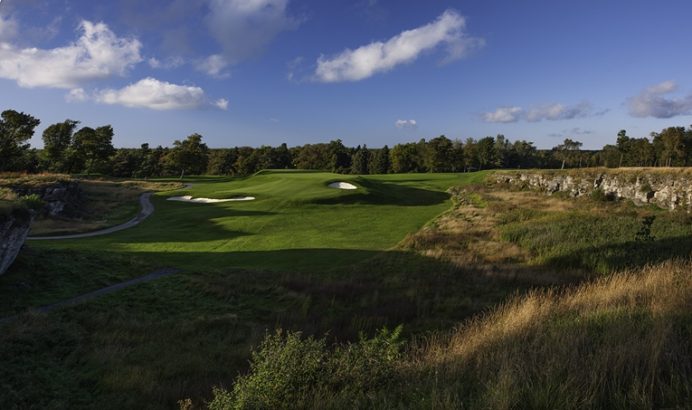
CC of Buffalo offers plenty of unique playing features. Photo courtesy of Larry Lambrecht/Golfstock.
Par 4 – This is really hard. There are so many. We will name two. Hole 1 Hyannisport Club, Cape Cod. 1930 Ross plans not well utilized. We kept the front 40% of the existing green, rebuilt the remainder as per his design. Also implemented his bunker scheme accurately. Very satisfying to give the start of this great gem, its authenticity – especially considering it had not existed beforehand.
Hole 7 Morris County Golf Club – Rollercoaster, tumbling, downhill fairway to a restored C. B. McDonald punchbowl green built by Seth Raynor.
Par 5 – Hole 7 Newport Country Club – Best part of it is the restored Great Hazard Area. We found a nest of features consisting of 13 bunkers flashed to apparently mimic white caps on the Atlantic. Herein using a small aerial photo and utilizing existing grass within the bunker we rebuilt the 4 large “bread loaf” mounds.
20. You are presently at Philadelphia CC. How did William Flynn tackle the land there vs. how you imagine Donald Ross might have?
A good question. It is hard to surmise. But what we do know is Flynn often routed holes in side hill or reverse camber fashion. In my opinion, Flynn was a very “athletic” golf designer. Some of his routings went straight up hills and straight down using dramatic changes in grade. He was an American architect who was a good tennis player and part owner of the Philadelphia Eagles. I think he had a more robust view of golf than did his Scottish counterparts. Ross tended to route in a more mild and walkable way. At Philly Country Flynn has very mild routing for most of the course because it was readily available and it was masterfully done. Both architects would traverse extreme topography often with the use of Par 3s.
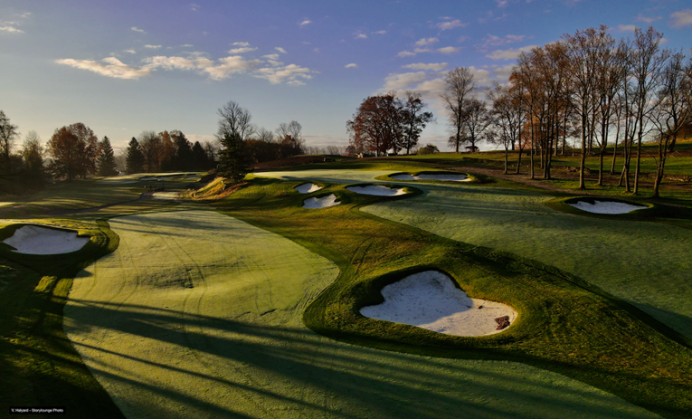
The Centennial Course at Philadelphia Country Club. Photo courtesy of Vaughn Halyard.
21. Tell us what Jim Nagle has meant to Forse Design for the past 22 years.
It’s nearly 23 years now. I stole Jim away from a prominent Landscape Architecture firm in early 1998. Forse Design is a team effort. Jim has a tremendous work ethic and is a consummate professional. Our complimentary skill-sets work to consistently give our clients seamless excellence. We’re not only colleagues but good friends.
22. The term ‘restoration’ can apply to courses built after World War II too. Please talk to us about your long-time association with Pine Tree and another Dick Wilson course, Hole-in-the-Wall GC in Naples.
Known primarily for classic era restoration, we also thoroughly enjoy the best of the modern era. Dick Wilson worked for William Flynn and learned a lot from him, but was not a copycat. His best work of the aerial attack modern era was probably Pine Tree Golf Club in Boynton Beach, FL built in 1961 (NCR in Ohio put him on the map, initially.) Pine Tree would become famous, staying for many years in the Top 100 of most magazines.
In 1997, we restored all 130 bunkers (65 green side and 65 fairway ones) using photographs purportedly commissioned by Ben Hogan. We also used a 1965 aerial photo. So, we had plan-view and eye-level reference. The greens were rebuilt as well as the entire 10th Hole. In 2012 all green side bunkers were rebuilt once more, restoring them to the photos precisely. Three years ago, all the putting surfaces were reconstructed again. Currently we are wrapping up a long-range improvement plan update that should nicely finish the course details not yet addressed. It was a real honor getting this commission having competed against 2 dozen other architects. This course is Wilson’s masterpiece, a great golf course built on flat land. We learned a lot about bunker variety and artistry at Pine Tree – a big influence on our practice. This gave us confidence in attacking the project at the Country Club of Orlando, which was nearly as flat. Pine Tree and it demonstrate that creating a stellar golf course, with varying angles and strong strategies, is possible even without undulating ground.
Another Wilson gem in Florida is the Hole-In-The-Wall Golf Club in Naples, circa 1958. Originally designed at over 6800 yards, it was reduced to its cozier length because it was to serve as an amenity for the Port Royal home development. It is still plenty long enough and is a great test of golf. Also, it is one of only a handful of courses in all of southwest Florida with no houses or buildings. Pure golf in a pristine, natural setting. In 2009, the entire course was reconstructed to solve some severe drainage problems. Storm water retention on site was required by the city resulting in water feature expansion and a new, large lake. Excavation provided fill to raise the elevation of the course. Here, we also used old photos, taken from an airplane, to recapture the footprints of the putting surfaces, which had become mundane in shape and uninteresting over time. With our knowledge of Wilson’s later work at Pine Tree – the pinnacle of his art form – we implemented a more robust bunker scheme with much more character and interest than was originally built. This is another good example of “interpretive restoration” where the course can remain entirely authentic yet significantly upgraded.
We are fascinated by the similarities, as well as the differences, between these two truly great courses by the same architect.
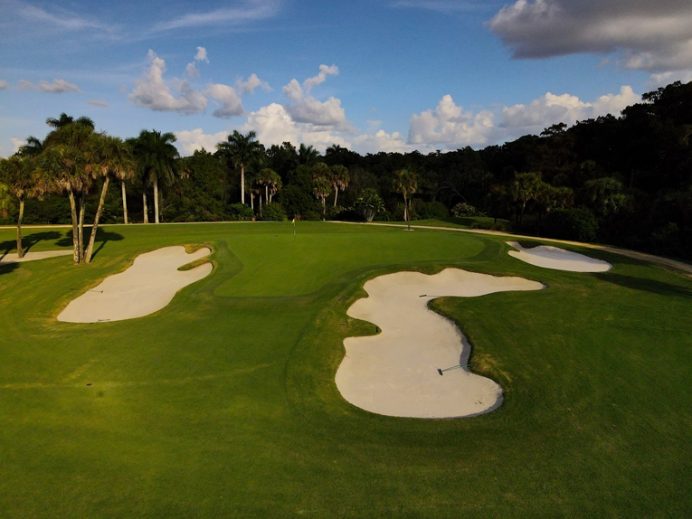
The 2nd green at Hole-in-the-Wall. Photo courtesy of Vaughn Halyard.
23. I agree with you that Wilson is underrated, especially as his courses enjoy their own aesthetic and he always built-in fascinating playing angles. Finally, what do you hope Forse Design’s legacy will be? The nature of being a restorer is that your name always comes second!
Our payback is knowing we have done the right thing with fidelity for the original architect who usually was masterful at his craft. This has to be done in consideration of the modern game equipment and turf conditions and all wrapped up in the architectural elements of strategy, variety and naturalness. We get a charge out of “being” the various old architects and making it look like we had never been there. And this builds our design repertoire too. We’ve done original golf courses but there is something about keeping the legacy of the past masters alive and thriving. We have a lot to be thankful for.
24. Why should a club hire Forse Design?
The sample restorative efforts mentioned above – from the Country Club of Orlando to Bedford Springs to Pine Tree – recaptured and showcased the design genius found in each. Our passion helped us to dig deep into the forensics and archives available and reclaim great, lost features and revitalize course essence. Meanwhile, our portfolio of knowledge and experience enables us to assess and deliver a variety of solutions on behalf of each club.
These disparate projects can all be defined as restoration because we are reclaiming the essence of each course though each followed an individual but appropriate path. It’s really gratifying to regain the original, compelling golf experience. We are good at that to the point where, for example, one member of Pine Tree Golf Club commented post-restoration that the course was back to how it was 45 years earlier. It’s our passion to deliver in a manner faithful to the original architect.








